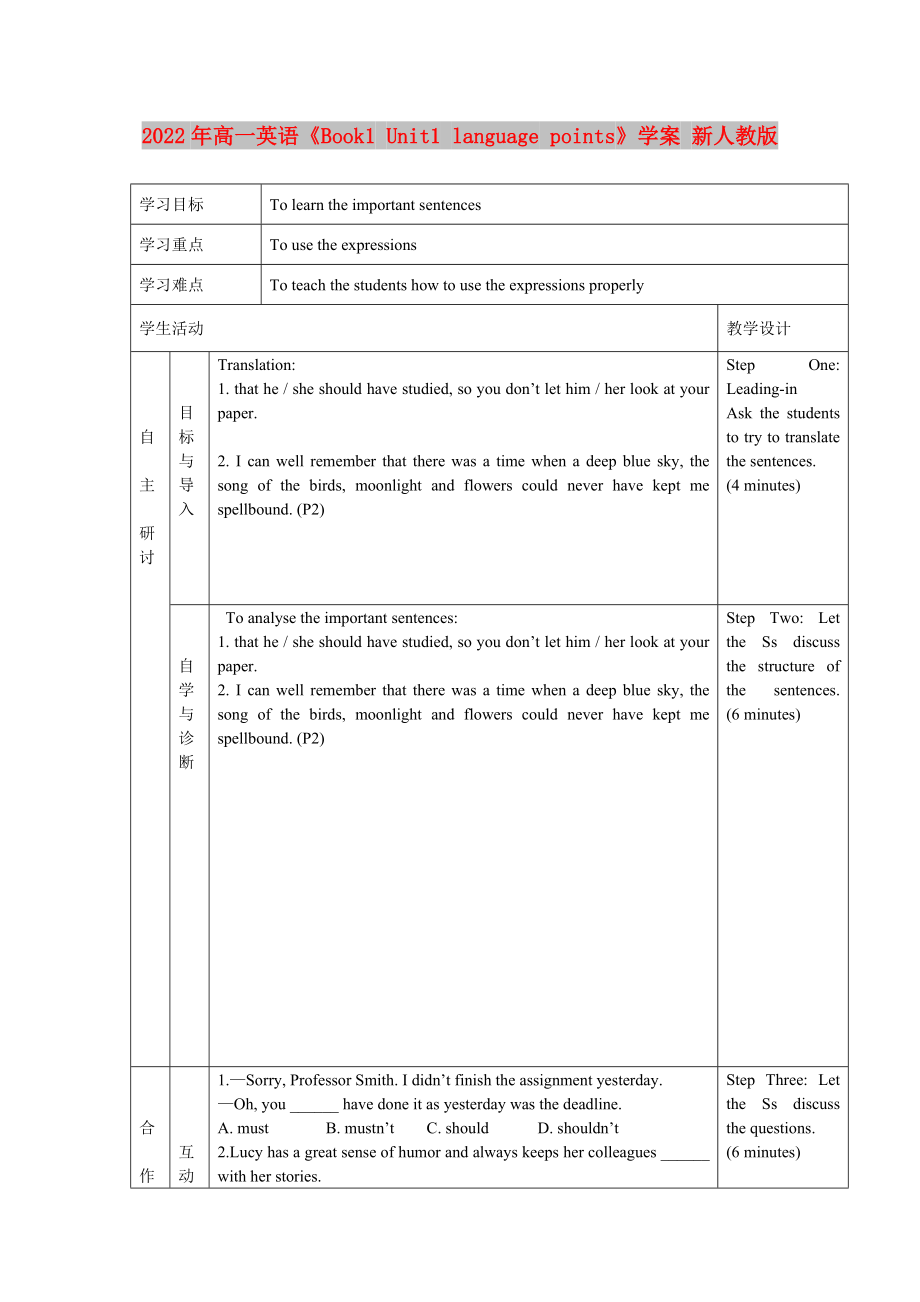《2022年高一英語(yǔ)《Book1 Unit1 language points》學(xué)案 新人教版》由會(huì)員分享��,可在線(xiàn)閱讀�,更多相關(guān)《2022年高一英語(yǔ)《Book1 Unit1 language points》學(xué)案 新人教版(3頁(yè)珍藏版)》請(qǐng)?jiān)谘b配圖網(wǎng)上搜索。
1���、2022年高一英語(yǔ)《Book1 Unit1 language points》學(xué)案 新人教版
學(xué)習(xí)目標(biāo)
To learn the important sentences
學(xué)習(xí)重點(diǎn)
To use the expressions
學(xué)習(xí)難點(diǎn)
To teach the students how to use the expressions properly
學(xué)生活動(dòng)
教學(xué)設(shè)計(jì)
自
主
研
討
目標(biāo)與
導(dǎo)入
Translation:
1. that he / she should have studied, so you don’t let
2�����、him / her look at your paper.
2. I can well remember that there was a time when a deep blue sky, the song of the birds, moonlight and flowers could never have kept me spellbound. (P2)
Step One: Leading-in
Ask the students to try to translate the sentences.
(4 minutes)
自學(xué)與診斷
To analy
3�����、se the important sentences:
1. that he / she should have studied, so you don’t let him / her look at your paper.
2. I can well remember that there was a time when a deep blue sky, the song of the birds, moonlight and flowers could never have kept me spellbound. (P2)
Step Two: Let the Ss discuss
4��、 the structure of the sentences. (6 minutes)
合
作
互
動(dòng)
互動(dòng)與展示
1.—Sorry, Professor Smith. I didn’t finish the assignment yesterday.
—Oh, you ______ have done it as yesterday was the deadline.
A. must B. mustn’t C. should D. shouldn’t
2.Lucy has a great sense
5��、of humor and always keeps her colleagues ______ with her stories.
A. amused B. amusing C. to amuse D. to be amused
3.This is the first time we ______ a film in the cinema together as a family.
A. see B. had seen C. saw D. have seen
4. It was last night ___ I saw the car.
6���、
A. where B. when C. that D. which
Step Three: Let the Ss discuss the questions.
(6 minutes)
精講與點(diǎn)撥
1.選C�。題意為“對(duì)不起�����,史密斯教授���,我昨天沒(méi)有完成功課�?��!薄班?�,你應(yīng)該完成的���,因?yàn)樽蛱焓亲詈蟮钠谙蕖�!眘hould have done符合題意。
2.選A���。amuse與her colleagues之間是被動(dòng)關(guān)系���,故A項(xiàng)正確。
3.選D��。由主句中的is可知�����,從句時(shí)態(tài)應(yīng)用現(xiàn)在完成時(shí)�。
4.選C. 強(qiáng)調(diào)句的結(jié)構(gòu)是: It +be +強(qiáng)
7、調(diào)部分 + that (who) + 主謂句�。 強(qiáng)調(diào)句的連詞只有兩個(gè),that和who���。當(dāng)強(qiáng)調(diào)的部分是人�,且為句子的主語(yǔ)時(shí)�,才用 "who",其余用that�。
Step Four: Ss show their answers and reasons.
(8 minutes)
檢
測(cè)
與
評(píng)
價(jià)
總結(jié)與升華
1. should have done表示“本來(lái)應(yīng)該做而未做”;shouldn’t have done表示“本來(lái)不應(yīng)該做而做了”���。
2. keep sb. / sth. done表示“讓某人/某事處于被…
8�、…”,do與sb. / sth. 之間是被動(dòng)關(guān)系�。
3. that從句中的謂語(yǔ)動(dòng)詞一般用完成時(shí)態(tài)。
4. 強(qiáng)調(diào)句基本結(jié)構(gòu):
It is/ was + 被強(qiáng)調(diào)部分(通常是主語(yǔ)�����、賓語(yǔ)或狀語(yǔ))+ that/ who(當(dāng)強(qiáng)調(diào)主語(yǔ)且主語(yǔ)指人)+ 其他部分�����。
Step Five: The teacher explains something when necessary and lead the Ss to conclude the language points.
(8 minutes)
達(dá)標(biāo)檢測(cè)題
Translation:
1) Is it he who wants to see you.
2) It was Mike and Mary who helped the old man several days ago.
3) Where was it that you met the foreigner from Canada?
Step Six: The Ss try to translate the sentences.
(8 minutes)
課后反思:
 2022年高一英語(yǔ)《Book1 Unit1 language points》學(xué)案 新人教版
2022年高一英語(yǔ)《Book1 Unit1 language points》學(xué)案 新人教版

